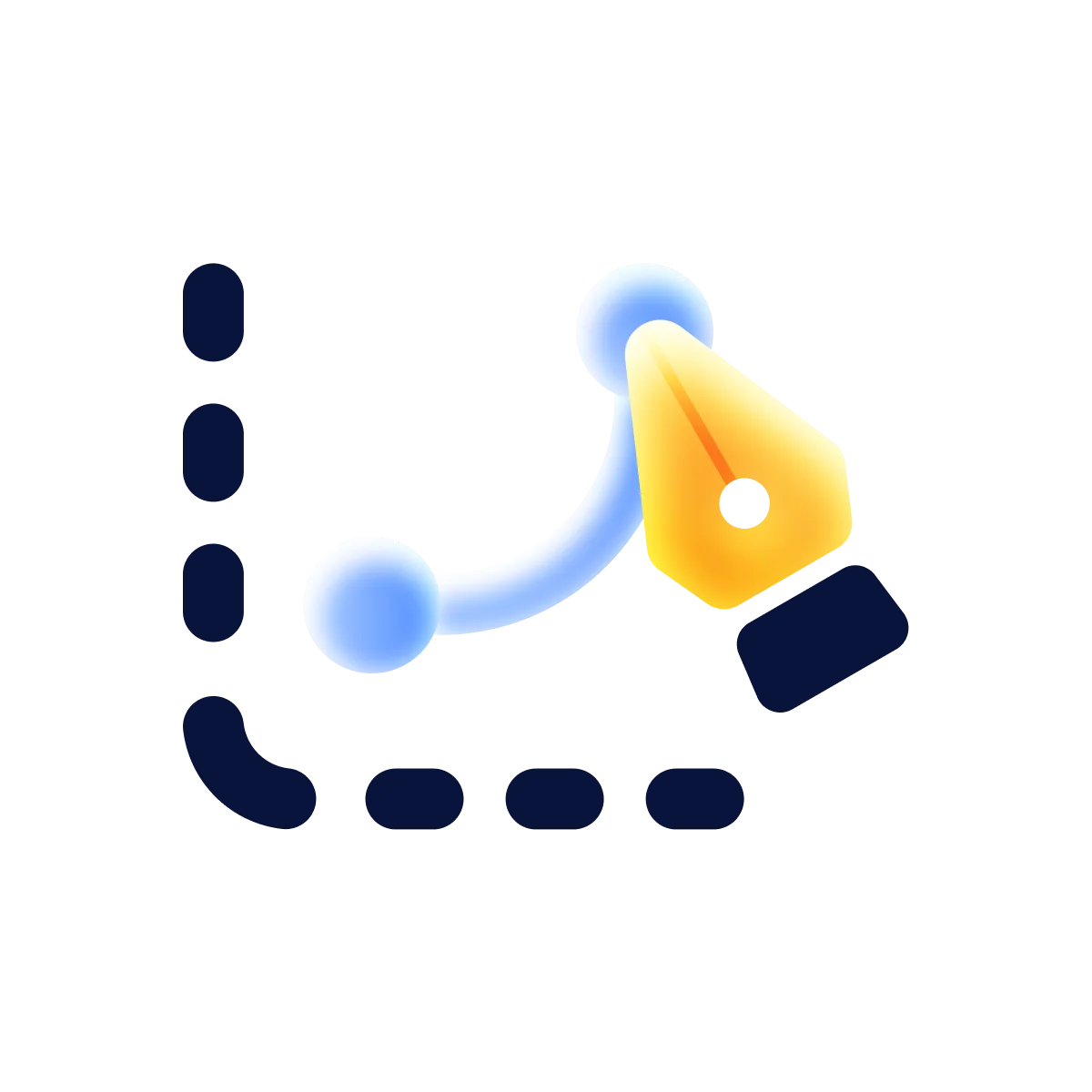Logos… how much meaning that one word contains. It even sounds poetic in a way — “Your right Type of Logotype”. Many people think that a logo is the face of a company because this is the first thing consumers notice when interacting with a brand. However, a brand encompasses much more than that — image, character, metaphors, and general positioning on the market and beyond. And its logo should be able to creatively convey that information.
Logos are designed for the long run. With that in mind, they should be recognizable to the customers and clearly associated with the product. For a logo to really become the face of a brand and stand the test of time, you need to consider many things, including what type of logo to go after. Yes, there are many different types of logos: monograms, letterforms, wordmarks, symbols, abstract logos, combination logos, mascots, and dynamic logos.
Let’s take a look at them all.
Monograms
Monograms, sometimes called acronyms, are one of the simplest and most minimalist types of logos. You surely know the logos of IBM, CNN, HP, HBO, and the like, right? These famous business logos are great examples of acronyms that represent the initials of companies. This type of logo is used to gracefully shorten long company names to just 2–4 letters.
A logo will be twice as memorable if the acronym looks and sounds cool — take NASA, for example. Conversely, it would be boring if the words begin with the same letter, for instance, Music Media Manufacturing (MMM), asit would be difficult to emphasize identity and uniqueness through that combination.

Letterforms
Since we started talking about logos consisting of letters, let’s continue on — the next stop is the letterform. Unlike monograms, which use two or more letters, letterforms are based on a single one. It can be either formal and recognizable or stylized, carrying additional meanings. Letter-based logos are an all-time classic and most effective for personal branding. They look simple but stylish and are a great example of minimalism. And they work! You can instantly recognize the “M” in McDonald’s and “N” in Netflix, can’t you?
The advantages of letterform logos are scalability — since they include a minimum of elements, they can easily be scaled down to be used for app or social media icons and the like. Here are a couple of other good examples for you.

Wordmarks
And to conclude with the letters, let’s look at wordmarks. Without symbols or illustrations, typography becomes the centerpiece, and the stylized company name needs to be the visual reference point for the brand. Think of well-known examples like Coca-Cola, Google, and The New York Times.
However, even without images, there’s plenty of room for artistic flavor when it comes to choosing fonts, colors, character features, spacing, and shapes. It’s a real feat for a designer to delicately pick a font that will fit a given company (or even to draw their own letters, which is called lettering).
To summarize, wordmarks convey meaning and reflect a brand’s personality, whether playful, artistic, educational, or profound.

Symbols
And now, let’s discuss logos featuring images or recognizable shapes. Naturally, I’m talking about symbols or standalone elements. A symbol can imitate or represent a real object or take a completely abstract form. However, this type of logo does not incorporate a company name, which is a big risk for new businesses that want to make their names big.
Such trademark logos are best for brands that have already gained recognition. If you think of this, what symbols come to your mind straight away? Perhaps a twitting blue bird? Or maybe a bitten apple?
Basically, the purpose of such logos is to make the image they rely on to be the only reference to the brand. Most successful brands use the combined type of logo in the beginning (see below) and only switch to symbols once they’ve earned enough recognition.

A logo is the beating heart of a brand, and as a designer, it is my responsibility to craft a logo that truly reflects the essence of the business it represents. Whether it be through the use of bold colors and striking imagery or a more subtle, understated approach, my goal is always to create a logo that speaks to the soul of the brand and leaves a lasting impression on its audience.
{{mais-t}}
Abstract logos
Of all the other types, abstract logos harness the power of imagery, symbolism, and metaphor to the fullest. The idea behind them is to express the basic principles of the brands they represent. It can be a combination of well-known images, shapes, or something completely unconventional. However, it is important for an abstract logo to be simple — that will ensure it is recognizable.
It is worth remembering that anything simple can carry a complex meaning if you manage to convey it correctly. The right branding and marketing campaigns work well with abstract logos, adding sense to the brand’s mark.

Combination logos
The combination logos include many features of the previously mentioned types, such as symbols or abstract logos combined with wordmarks. The combination logos are a great choice for almost any business. They are versatile, usually highly unique, and are the most popular choice among well-known companies. Combination logos allow for conveying a visual representation of what a brand is all about as well as giving an idea of what it is called, so the new or lesser-known brands can also benefit from them.
Such logos are also easier to patent correctly. In these cases, you patent your logo and the wordmark both separately and combined, and this offers greater flexibility for their future use.

Mascots
This is one of the more complex yet understandable types. Mascot logos feature an illustrated character who acts as a brand’s ambassador. These logos are often fun and friendly as they communicate with the audience on behalf of the brand.
What makes mascots different from the other types is that they represent a particular character, and we are visually stimulated when recognizing a human face or a familiar animal image. In this case, the brand will be closer to its audience, and you can really think of them as ambassadors for businesses.
Famous mascots include the Kool-Aid Man, the KFC Colonel, and Mr. Peanut. Generally, mascots are great for companies that want to create a welcoming atmosphere and appeal to families and children.

Dynamic logos
Like the combined type, dynamic logos can also incorporate various subtypes. Abstract signs, symbols, or letterforms can all be included in dynamic logos. This type of logo is more suited for brands in the digital space — those that practically never use offline media, conducting their business solely in the digital environment.
They’re called dynamic because of the huge potential for their use — these logos behave differently on various sites and occasions, taking on the features of branding. You can use this kind of logo to communicate a holiday spirit, emotions, or even sounds (if you know what you’re doing, that is).

The Casa Da Musica logo (for the music center in Portugal designed by Rem Koolhaas) is one such good example. The center needed a universal style, so they turned to a designer who developed a dynamic logo inspired by the architectural shape of the building, featuring varying perspectives and a customizable color palette.

Here are some more examples of dynamic logos.

So how to choose the right type of logo
When choosing the type for a new logo, you need to think about its flexibility and practicality. It is important that it can be scaled to different sizes, looking great both on printed products and social media profile pages. There’s a reason why brands often choose not to focus on only one format but create different variants of logos — both with and without a symbol (monogram) — they want to have different options at the ready.
The design (font, images, colors) of a logo should primarily describe your brand, its spirit and philosophy. Do not copy someone’s idea; instead, try to make the logo unique — your company will be more visible and recognizable if it stands out from other similar ones.
As the design team lead at Halo Lab, I can attest to the importance of a well-designed logo in building a strong brand identity. At our company, we believe that a logo should be more than just a pretty image — it should communicate the values and essence of a brand in a way that resonates with its target audience. That’s why we take the time to really get to know our clients and their businesses and use that understanding to craft logos that truly represent who they are and what they stand for. When it comes to logo design, we don’t just create — we transform.
If you want your logo to be unique, conveying all the intricacies of your brand at first glance, contact us, and we’ll create something great together!
in your mind?
Let’s communicate.






























